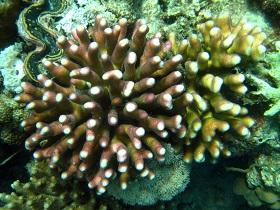Using AI to control energy for indoor agriculture
30 September 2024
Published online 23 July 2013

A study to determine the function of bacteria inside coral tissues has found that it may act as a "middle man", converting photosynthetic products from surrounding algae to a state from which the coral can draw energy.
As scientists search for solutions to the rapid decline of the world's coral population – which has shrunk by 30% in the past three decades – they are keen to unravel the symbiotic relationship between coral and bacteria.
It has long been known that the outer layer of mucus which surrounds and protects corals is full of bacteria. But a team of researchers from the King Abdullah University of Science and Technology (KAUST) and the Woods Hole Oceanographic Institution (WHOI) has found that the relationship between the two can be much more sustaining.
Most of the bacterial biomass in the coral species Stylophora pistillata – a species of reef-building corals found in the Indian and Western Pacific oceans – was found to be located inside the coral's cells. This endosymbiosis may be responsible for maintaining coral health.
"It's one thing for a bacteria to be found on the coral's outside layer of mucus, and quite another to find it inside the animal cell," says marine scientist Christian Voolstra, who co-authored the study. referring to the rarity of this phenomenon among marine animals. "We need to understand why the coral allows the bacteria to colonize its cells."
The researchers used fluorescence in situ hybridization, a common technique used to probe genetic material for specific marker DNA sequences, to detect bacteria in coral tissue and pinpoint their location.
They found bacteria from the genus Endozoicomonas inside the cells of Stylophora pistillata in a larger quantity than any other bacteria. This suggests a much more advanced symbiotic relationship than expected, they say in their paper published in Applied and Environmental Microbiology1.
The bacteria form a distinct grape-shaped structure within the coral's cells. "There must be a specific product that they break down," explains Voolstra. While there are different hypotheses that try to explain this co-localization, the KAUST and WHOI researchers will focus their ongoing experiments on the coral's metabolism.
Understanding the function of this bacterium could potentially make it an extremely useful indicator of corals’ health.
Since most corals live in nutrient poor waters, 95% of their energy comes from sunlight captured by the photosynthetic algae that live with them. Voolstra and his team suggest that the bacteria may convert some of the photosynthetic products from the algae to a form that is useable by the coral.
To verify this hypothesis, the researchers are growing cultures of a couple of Endozoicomonas species in their lab from which metabolites can be isolated and characterized. "Hopefully this will tell us more about their purpose," Voolstra says.
"If we find one compound that this bacterium is particularly good at synthesizing, then the next step will be to identify that compound in relation with corals."
Understanding of corals' immunity is in its infancy because research in coral molecular biology only began 10 years ago. "While what is detrimental to corals' health is obvious, scientists don't know much about what's beneficial," says Voolstra. "If we find out that these bacteria are actually good for the corals, this would be a good indicator."
Mahmoud Hanafy, a marine biologist at Suez Canal University, Egypt, and chief scientist at the Hurghada Environmental Protection and Conservation Association (HEPCA), suggests these bacteria be used as an alarm system for conservationists.
"This discovery is extremely important, because understanding the function of this bacterium could potentially make it an extremely useful indicator of corals' health," he says.
The rapid shrinking of these underwater forests, caused mainly by climate change, ocean acidification, coastal degradation and overfishing, shows no sign of abating.
"Understanding the symbiotic relationship between these bacteria and the coral would expand what we know about how this organism works, which would in turn help protecting it," says Hanafy.
doi:10.1038/nmiddleeast.2013.108
Stay connected: